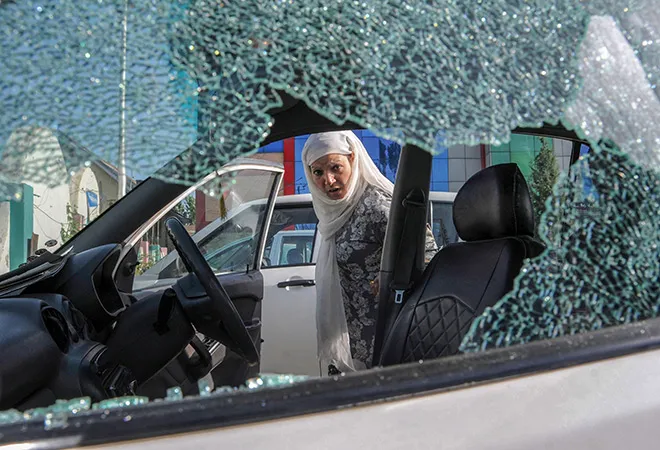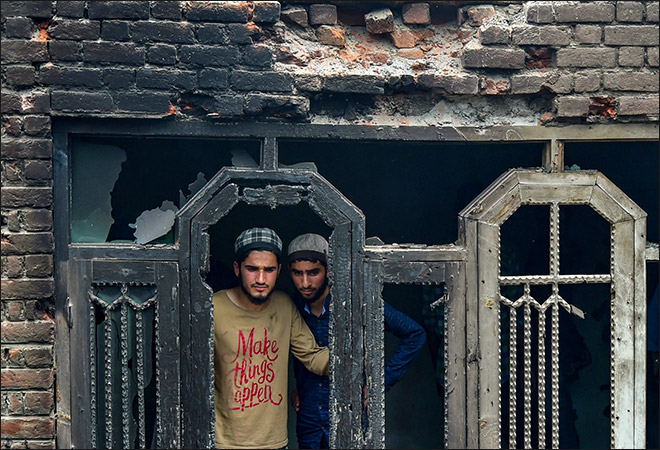
Two years after Hizbul Mujahideen commander Burhan Wani was gunned-down, the ‘Burhanwali Aazadi’ sentiment propagated by his followers has added fuel to home-grown insurgency in Kashmir. Infatuated by their idol, the new home-grown breed of terrorists do not hesitate in romancing the gun online. They are brainwashed into a misplaced bravado and fearlessness, use every available digital tool for social media publicity, create sympathy for their ‘cause’ and manage perceptions by communicating regularly with radicalised youth of the Valley, in their search for prospective recruits. By weaponising social media, they seem to have successfully etched the message of jihad on the Kashmiri mindset, lured the vulnerable youth to participate in street violence, introduced them to the gun, and finally, made them commit acts of terror.
Rampant use of social media platforms administering a lethal dose of radical content has given 30 years of extremism in Kashmir a methodical progression, where, like parasites, radical ideology, terror groups and their masters survive on the bruised Kashmiri mindset and their social, political and economic vulnerabilities. Used to deadly effect first by Burhan, social media platforms like Facebook, YouTube, WhatsApp, Twitter, Viber, Skype, Telegram, etc. have been further leveraged by Hizbul Mujahideen and Lashkar-e-Toiba. Their anti-India propaganda include videos of terrorist training sessions and alleged harassment of locals by the security forces to infuriate the vulnerable youth. ‘Cyber jihad’ has established firm roots in the Valley, churning out new-age militants to keep the terror plot boiling.
Rampant use of social media platforms administering a lethal dose of radical content has given 30 years of extremism in Kashmir a methodical progression.
Following a six-month probe into incidents of unrest in Kashmir in 2017, a team of National Investigation Agency (NIA) identified 79 WhatsApp groups, having 6,386 phone numbers, used to crowdsource boys for stone pelting. Of them, around 1,000 numbers were found active in Pakistan and Gulf nations. The remaining 5,386 numbers were found active in various parts of the Valley and neighbouring States. Many of these groups had administrators based in Pakistan. According to a media report, more than 300 WhatsApp groups operated to crowdsource mobs to disrupt anti-terror operations in 2017.
 Influenced by online propaganda, young boys morph into big crowds. | Source: PTI
Influenced by online propaganda, young boys morph into big crowds. | Source: PTI
The number of youth in Kashmir with free access to social media grew from 25 percent in 2010 to over 70 percent in 2015. Since then, this number can be safely assumed to have grown further. To control the e-jihad that spread post Burhan Wani’s encounter, the government responded by blocking internet signals for five months in 2016. Generally, internet curfews suspend 3G and 4G networks and social media apps, but the State-owned BNSL network, which is used primarily by the administration and security forces, is kept functional. In any case, these e-curfews have little meaning as terror groups and individuals use the Virtual Private Networks (VPNs) to overcome such security-mandated subversions.
Constant hate propaganda on the internet has also streamlined the process of radicalisation and recruitment. So intertwined the ground realities and online campaigns are that one can hardly be differentiated from the other. Anti-national activities and terrorist propaganda are made to appear legitimate as the new recruits are projected as the victims of the Indian state and saviours of Kashmir. For the said purpose, the terror masters need not resort to illegal measures; social media gives them the cover, space and speed to influence the youth.
So intertwined the ground realities and online campaigns are that one can hardly be differentiated from the other. Anti-national activities and terrorist propaganda are made to appear legitimate as the new recruits are projected as the victims of the Indian state and saviours of Kashmir.
Influenced by online propaganda, young boys gradually morph into big crowds, which are mobilised to pelt stones, set schools on fire and act as human shield for terrorists to escape from encounter sites. Since 2014, there has been a steady rise in the number of local boys joining terrorism. During 2010-13, the figures stood at 54, 23, 21 and six in respective years. In 2014, this figured jumped to 53, while in 2015, 66 boys joined terrorism. Immediately after Burhan Wani’s encounter, this number jumped by 55 percent, with nearly 90 boys joining terrorism in just a few weeks. In 2017, nearly 120 new boys embraced militancy as against over 200 killed. In the current year, nearly 90 boys are reported to have picked up arms. While online radicalisation doesn’t prove their criminality, extremist ideology and anti-India propaganda, coupled with a growing sense of resentment caused by mis-governance and nepotism by the ruling elite, pushes them further towards the tipping point. Flaunting Kalashnikov rifles and uploading their photographs online becomes the declaration of their intent. The ‘us versus them’ narrative is clearly communicated, creating groundswell of support for terrorism.
In an attempt to control this vicious cycle of radicalisation and recruitment fueling further violence in the Valley, nearly 10,000 boys involved in stone pelting incidents between 2008 and 2017 have been given amnesty. However, this is no reprieve for the bruised Kashmiri mindset.
A generalist attitude towards terrorist propaganda on social media will not work. A strategic narrative communicating the other side of story needs to be presented before the Valley. A dedicated ‘cyber defence complex’ (CDC) is needed to be established to defend the ‘digital homeland’ and it must become an integral part of the Kashmir policy. Earlier the war of narratives was fought from the mosques and mohallas (town squares). But today it is done from the cyber platforms as they make use of every anti-India incident to dent the country’s image in Kashmir. While the paramilitary forces, police and the army must be the primary players in such an establishment, the traditional tools of engaging the local communities must also get prominence.
The views expressed above belong to the author(s). ORF research and analyses now available on Telegram! Click here to access our curated content — blogs, longforms and interviews.




 Influenced by online propaganda, young boys morph into big crowds. | Source: PTI
Influenced by online propaganda, young boys morph into big crowds. | Source: PTI PREV
PREV


